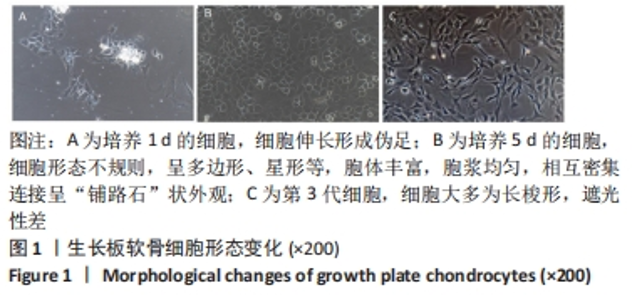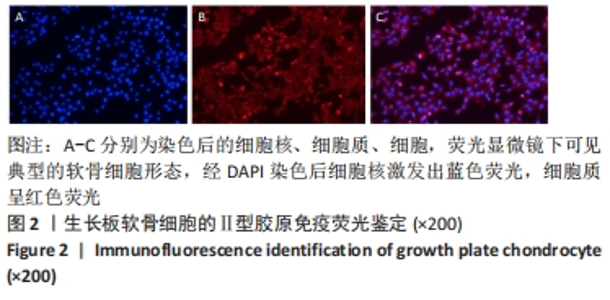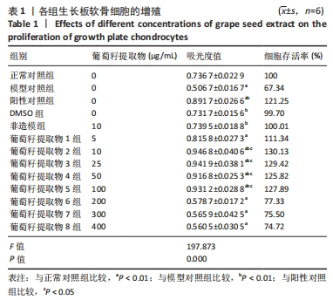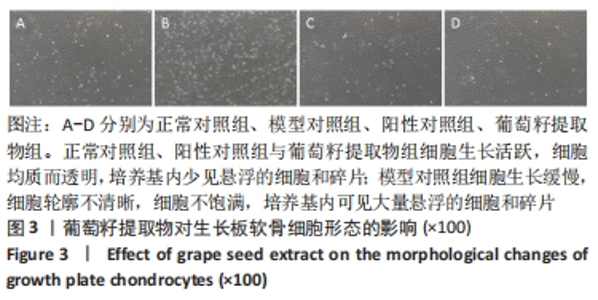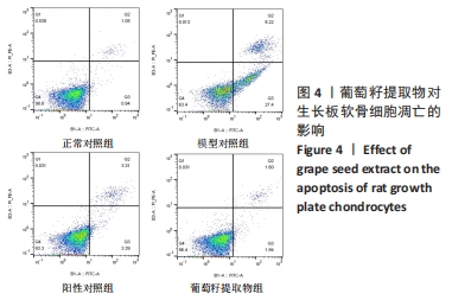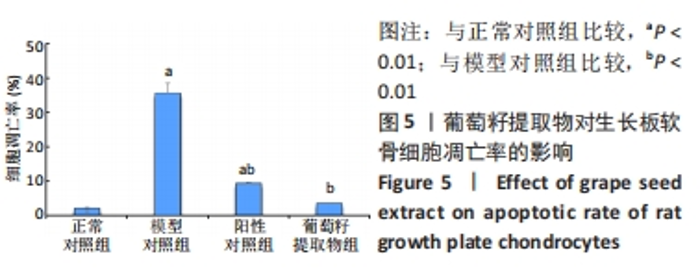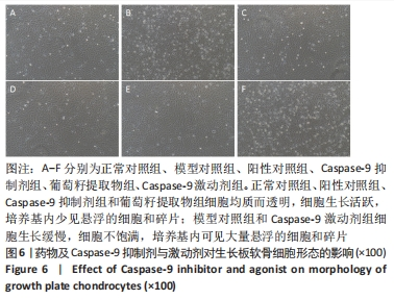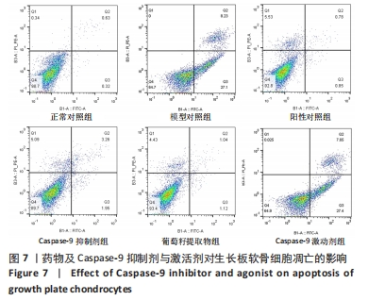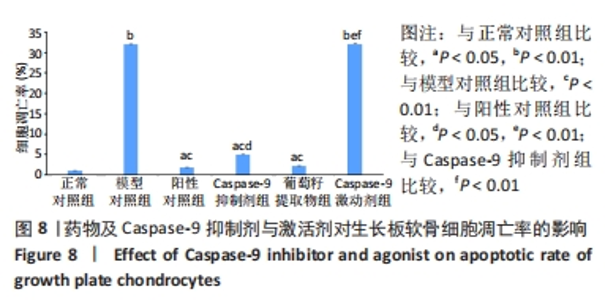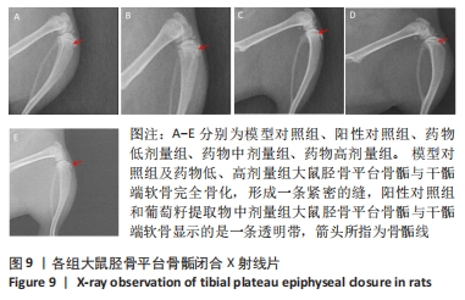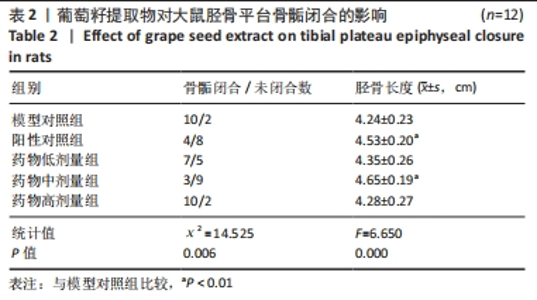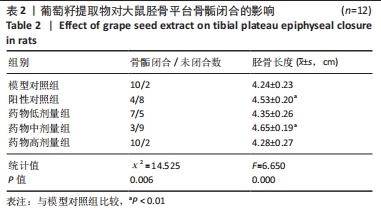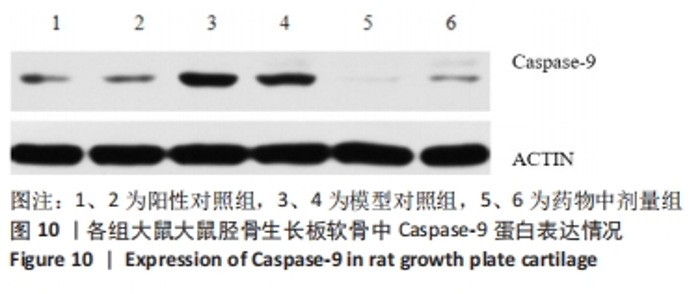Chinese Journal of Tissue Engineering Research ›› 2024, Vol. 28 ›› Issue (20): 3216-3222.doi: 10.12307/2024.310
Previous Articles Next Articles
Grape seed extract inhibits apoptosis in growth plate chondrocytes and promotes tibial growth in rats
Ning Taoli, Xie Yan, Wang Na, Wang Qingfeng, Ji Jian, Zhang Dongna
- Henan Provincial Luoyang Orthopedic-Traumatological Hospital (Henan Provincial Orthopedic Hospital), Luoyang 471000, Henan Province, China
-
Received:2023-03-07Accepted:2023-04-24Online:2024-07-18Published:2023-09-11 -
Contact:Wang Na, Associate chief technician, Henan Provincial Luoyang Orthopedic-Traumatological Hospital (Henan Provincial Orthopedic Hospital), Luoyang 471000, Henan Province, China -
About author:Ning Taoli, Pharmacist-in-charge, Henan Provincial Luoyang Orthopedic-Traumatological Hospital (Henan Provincial Orthopedic Hospital), Luoyang 471000, Henan Province, China -
Supported by:Special Research Projects of Traditional Chinese Medicine of Henan Province, Nos. 2019ZY1034 (to WN) and 2019ZY2098 (to NTL [project participant])
CLC Number:
Cite this article
Ning Taoli, Xie Yan, Wang Na, Wang Qingfeng, Ji Jian, Zhang Dongna. Grape seed extract inhibits apoptosis in growth plate chondrocytes and promotes tibial growth in rats[J]. Chinese Journal of Tissue Engineering Research, 2024, 28(20): 3216-3222.
share this article
Add to citation manager EndNote|Reference Manager|ProCite|BibTeX|RefWorks
| [1] 王香港,万谦,刘贺,等.组织工程软骨在生长板损伤修复治疗中的作用及特点[J].中国组织工程研究,2021,25(28):4539-4545. [2] 隋圣斌,巩纯秀.影响生长板上软骨细胞活动的信号通路及生长板生物钟[J].中国实用儿科杂志,2021,36(8):573-581. [3] 史升.雌激素对椎体和长骨骺板生长代谢差异性作用的实验研究[D].上海:上海交通大学,2017. [4] 孔元梅,陈虹,梁黎,等.芳香化酶抑制剂联合生长激素治疗青春期身材矮小症男性患儿的临床研究[J].浙江大学学报(医学版), 2020,49(3):283-290. [5] BUTLER M, MILLER J, FORSTER J. Prader-Willi Syndrome-Clinical Genetics, Diagnosis and Treatment Approaches: An Update. Curr Pediatr Rev. 2019;15(4):207-244. [6] LAMBETH LS, MORRIS KR, WISE TG, et al. Transgenic chickens overexpressing aromatase have high estrogen levels but maintain a predominantly male phenotype. Endocrinology. 2016;157(1):83-90. [7] KYLLI P, NOHYNEK L, PUUPPONEN-PIMIÄ R, et al. Lingonberry (Vacciniu vitis-idaea) and European Cranberry (Vaccinium microcarpon) Proanthocyanidins: Isolation, Identification, and Bioactivities. J Agric Food Chem. 2011;59(7):3373-3384. [8] 李坤,杨义芳.天然产物及其衍生物中的芳香化酶抑制剂[J].中草药,2008,39(9):1417-1424. [9] ZHANG Z, ZHENG L, ZHAO Z, et al. Grape seed proanthocyanidins inhibit H2O2-induced osteoblastic MC3T3-E1 cell apoptosis via ameliorating H2O2- induced mitochondrial dysfunction. J Toxicol Sci. 2014;39(5):803-813. [10] 谢艳,李无阴,邢伟鹏,等.抑制生长板软骨细胞凋亡药物筛选及白藜芦醇延迟大鼠骨骺闭合的作用[J].中国组织工程研究,2022, 26(23):3644-3649. [11] 潘思年,杜敏联,马华梅,等.大鼠胫骨生长板软骨细胞的体外培养及鉴定[J].中山大学学报(医学科学版),2009,30(S2):1-5+10. [12] 张宇曦,孔垂泽,李振华,等.17β雌二醇、他莫昔芬和雷洛昔芬诱导前列腺癌细胞凋亡及细胞周期阻滞的研究[J].中华实验外科杂志,2006(12):1526-1528. [13] 张宏都,谢艳,吕艳艳,等.鹰嘴豆素A对IL-1β诱导大鼠生长板软骨细胞凋亡及对胫骨生长的影响[J].中国医院药学杂志,2022, 42(18):1892-1896. [14] 李健.17-β雌二醇抑制IL-1β诱导的软骨细胞凋亡的作用机制研究[D].南昌:南昌大学,2016. [15] 卢伟,李德芳,朱斌,等.Caspase-9抑制剂对SD大鼠椎间盘软骨终板细胞凋亡的影响[J].中国实验动物学报,2014,22(5):17-21. [16] EKERT PG, SILKE J, VAUX DL. Caspase inhibitors. Cell Death Differ. 1999; (6):1081-1086. [17] EKERT PG, SILKE J, VAUX DL. Inhibition of apoptosis and clonogenic survival of cells expressing crmA variants: optimal caspase substrates are not necessarily optimal inhibitors. EMBO J. 1999;18(2):330-338. [18] 赵瑞.镉诱导线粒体ROS抑制XIAP通路导致神经细胞凋亡机理研究[D].南京:南京师范大学,2019. [19] 那学武,李扬,王振冉,等.Embelin通过PI3K/Akt信号途径抑制甲状腺癌细胞增殖[J].中国老年学杂志,2016,36(10):2340-2342. [20] 陈俊,吴广文,许惠凤,等.独活寄生汤干预膝骨关节炎模型大鼠软骨PERK/Bip信号通路的表达[J].中国组织工程研究,2018,22(28): 4493-4500. [21] MASARWI M, SHAMIR R, PHILLIP M, et al. Leptin stimulates aromatase in the growth plate: limiting catch-up growth efficiency. J Endourol. 2018;237(3):18-28. [22] 王善金,李新锋,戴力扬.瘦素与雌激素在骺板内的作用机制研究进展[J].中国骨与关节外科,2011,4(6):490-494. [23] SHIM KS. Pubertal growth and epiphyseal fusion. Ann Pediatr Endocrin. 2015;20(1):8-12. [24] 苏慧萍.骨成熟影响因素的研究进展[J].国际儿科学杂志,2020, 47(4):279-282. [25] HASHIMOTO S, OCHS RL, KOMIYA D, et al. Linkage of chondrocyte apoptosis and cartilage degradation in human osteoarthritis. Arthritis Rheum. 1998;41:1632-1638. [26] 李继斌,黎海芪,王松艳.雌激素对生长板软骨细胞增殖的调节[J].中国组织工程研究与临床康复,2011,15(11):1906-1908. [27] FILES JA, KO MG, PRUTHI S. Managing Aromatase Inhiaitors in Areast Cancer Survivors: Not Just for Oncologists. Mayo Clin Proc. 2010;85(6): 560-566. [28] 周金培,朱凤军,黄文龙.抗癌药来曲唑的合成研究[J].中国药科大学学报,2003,34(4):375-376. [29] 范连明.芳香化酶抑制剂(来曲唑)在治疗血清雌激素水平升高ED中的临床疗效观察[D].大连:大连医科大学,2017. [30] 李小玲,叶进.第三代芳香化酶抑制剂促生长作用的有效性及安全性[J].中南药学,2020,18(4):112-116. [31] 欧阳力雪,杨凡.芳香化酶抑制剂在矮身材青少年男童中的应用研究进展[J].中华实用儿科临床杂志,2020,35(9):712-715. [32] 王春林,梁黎.第三代非甾体类芳香化酶抑制剂在儿科内分泌临床应用的再认识[J].浙江大学学报(医学版),2020,49(3):275-282. [33] 陈晓静,何杰,杨建云,等.RP-HPLC法同时测定葡萄籽提取物中没食子酸、儿茶素和表儿茶素的含量[J].药物分析杂志,2015,35(4): 723-727. [34] 赵坤生,时倩,李秀昌.葡萄籽化学成分与药理作用研究进展[J].泰山医学院学报,2019,40(9):718-720. [35] TONG LX, YOUNG LC. Nutrition: The future of melanoma prevention? J Am Acad Dermatol. 2014;71(1):151-160. [36] YAMAKOSHI J, SAITO M, KATAOKA S, et al.Safety evaluation of proanthocyanidinrich extract from grape seeds. Food Chem Toxicol. 2002;40(5):599-607. [37] SONGJR, DONG Y. Effect of AI Combined with rhGH on Growth Rate, Bone Mineral Density and Bone Metabolism of Children with Idiopathic Dwarfism. Med Recapit.2020;26(24):4952-4956. [38] 雷晓,余佩武.双标记流式细胞术定量分析5-FU诱导胃癌细胞早期凋亡[J].第三军医大学学报,2002,24(7):855-857. [39] 张伟,梁智辉.Annexin V-FITC/PI双标记与Hoechst33342/PI双标记流式细胞术检测细胞凋亡的比较[J].细胞与分子免疫学杂志,2014, 30(11):1209-1212. [40] HIRAI T, CHAGIN AS, KOBAYASHI T, et al. Parathyroid hormone parathyroid hormone-related protein receptor signaling is required for maintenance of the growth plate in postnatal life. Proc Natl Acad Sci USA. 2011;108(1):191-196. [41] 矫翠翠,郑光源,付静静,等.Cyt-c和Caspase家族与面神经元凋亡的研究进展[J].中国临床研究,2021,34(9):1268-1271. [42] 刘江涛,郭雄,吴翠艳,等.线粒体细胞色素c介导的caspase-9激活通路参与大骨节病关节软骨细胞凋亡的发生机制[J].西安交通大学学报(医学版),2011,32(5):580-584. |
| [1] | Yang Yifeng, Ye Nan, Wang Lin, Guo Shuaicheng, Huang Jian. Signaling pathway of dexmedetomidine against ischemia-reperfusion injury [J]. Chinese Journal of Tissue Engineering Research, 2024, 28(9): 1464-1469. |
| [2] | Yue Yun, Wang Peipei, Yuan Zhaohe, He Shengcun, Jia Xusheng, Liu Qian, Li Zhantao, Fu Huiling, Song Fei, Jia Menghui. Effects of croton cream on JNK/p38 MAPK signaling pathway and neuronal apoptosis in cerebral ischemia-reperfusion injury rats [J]. Chinese Journal of Tissue Engineering Research, 2024, 28(8): 1186-1192. |
| [3] | Chen Zepeng, Hou Yonghui, Chen Shudong, Hou Yu, Lin Dingkun. Tauroursodeoxycholic acid treats spinal cord injury by reducing apoptosis of spinal cord neurons under glucose and oxygen deprivation [J]. Chinese Journal of Tissue Engineering Research, 2024, 28(4): 528-534. |
| [4] | Shen Feiyan, Yao Jixiang, Su Shanshan, Zhao Zhongmin, Tang Weidong. Knockdown of circRNA WD repeat containing protein 1 inhibits proliferation and induces apoptosis of chondrocytes in knee osteoarthritis [J]. Chinese Journal of Tissue Engineering Research, 2024, 28(4): 499-504. |
| [5] | Ran Lei, Han Haihui, Xu Bo, Wang Jianye, Shen Jun, Xiao Lianbo, Shi Qi. Molecular docking analysis of the anti-inflammatory mechanism of Cibotium barometz and Epimedium for rheumatoid arthritis: animal experiment validation [J]. Chinese Journal of Tissue Engineering Research, 2024, 28(2): 208-215. |
| [6] | Zuo Jun, Ma Shaolin. Mechanism of beta-sitosterol on hypertrophic scar fibroblasts: an analysis based on network pharmacology [J]. Chinese Journal of Tissue Engineering Research, 2024, 28(2): 216-223. |
| [7] | Wang Qian, Lu Ziang, Li Lihe, Lyu Chaoliang, Wang Meng, Zhang Cunxin. Sinomenine effectively inhibits interleukin-1beta-induced apoptosis in nucleus pulposus cells [J]. Chinese Journal of Tissue Engineering Research, 2024, 28(2): 224-230. |
| [8] | Chen Simin, Hu Yingjun, Yan Wenrui, Ji Le, Shao Mengli, Sun Ze, Zheng Hongxing, Qi Shanshan. Establishment and evaluation of a streptozotocin-induced diabetic encephalopathy rat model [J]. Chinese Journal of Tissue Engineering Research, 2024, 28(2): 237-241. |
| [9] | Zhao Kui, Pan Runsang, Lan Fengjun, Deng Jin, Chen Houping. Molecular mechanisms of autophagy-apoptosis interactions in osteoarthritis [J]. Chinese Journal of Tissue Engineering Research, 2024, 28(18): 2912-2917. |
| [10] | Zhang Shasha, Wang Na, Li Yongjun. Grape seed extract inhibits apoptosis of rat growth plate chondrocytes and promotes tibial bone growth [J]. Chinese Journal of Tissue Engineering Research, 2024, 28(16): 2494-2499. |
| [11] | Xie Wenguan, Liu Yutao, Cui Wenbo, Kuang Mingye. Melatonin inhibits hydrogen peroxide-induced injury of human nucleus pulposus cells [J]. Chinese Journal of Tissue Engineering Research, 2024, 28(14): 2180-2185. |
| [12] | Zhuang Zhikun, He Mincong, Lin Tianye, Wu Rongkai, Guo Jinhua, Wu Zhaoke, Wei Qiushi. Exploration and clinical validation of the repair mode of the sclerotic zone of steroid-induced osteonecrosis of the femoral head based on Tandem Mass Tags technology [J]. Chinese Journal of Tissue Engineering Research, 2024, 28(14): 2191-2196. |
| [13] | Yang Wanrong, Chu Yi, Xu Yao, Li Sihui, Guo Ling. Ginsenoside Rg1 inhibits H2O2-induced apoptosis and autophagy in human periodontal ligament cells [J]. Chinese Journal of Tissue Engineering Research, 2024, 28(13): 2061-2067. |
| [14] | Fan Zhihong, Zhang Xian, Li Chao. Wnt signaling pathway in intervertebral disc degeneration [J]. Chinese Journal of Tissue Engineering Research, 2024, 28(12): 1950-1955. |
| [15] | Mo Jian, Ye Sentao, Zhang Xiaoyun. Progress in the treatment of knee osteoarthritis with monomer and compound Chinese medicine [J]. Chinese Journal of Tissue Engineering Research, 2024, 28(11): 1756-1761. |
| Viewed | ||||||
|
Full text |
|
|||||
|
Abstract |
|
|||||
